The Boy With Green Hair (1948) and The Iron Curtain (1948)
By Toronto Film Society on October 1, 2020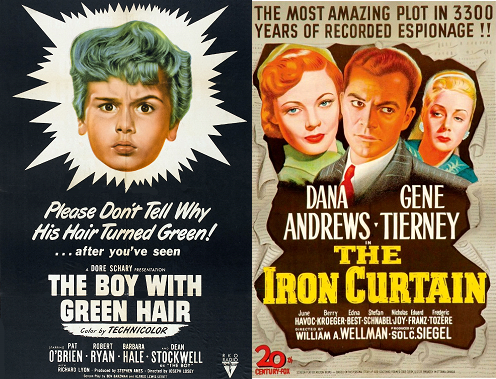
Toronto Film Society presented The Boy With Green Hair (1948) on Monday, March 13, 1989 in a double bill with The Iron Curtain (1948) as part of the Season 41 Monday Evening Film Buffs Series “D”, Programme 5.
The Boy With Green Hair (1948)
Production Company: RKO. Director: Joseph Losey. Producer: Stephen Ames. Screenplay: Ben Barzman and Alfred Louis Levitt, from the story by Betty Beaton.
Cast: Pat O’Brien (Gramp), Robert Ryan (Dr. Evans), Barbara Hale (Miss Brand), Dean Stockwell (Peter), Richard Lyon (Michael), Walter Catlett (“The King”), Samuel S. Hinds (Dr. Knudson), Regis Toomey (Mr. Davis), Charles Meredith (Mr. Piper), David Clarke (Barber), Billy Sheffield (Red), John Calkins (Danny), Teddy Infuhr (Timmy), Dwayne Hickman (Joey).
The Iron Curtain (1948)
Production Company: Twentieth Century Fox. Director: William A. Wellman. Producer: Sol C. Siegel. Screenplay: Milton Krims, based on the personal story of Igor Gouzenko.
Cast: Dana Andrews (Igor Gouzenko), Gene Tierney (Anna Gouzenko), June Havoc (Karanova), Berry Kroeger (John Grubb), Edna Best (Mrs. Foster), Stefan Schnabel (Ranev), Nicholas Joy (Dr. Norman), Eduard Franz (Major Julin), Frederic Tozere (Col. Trigorin), Noel Cravat (Bushkin), Christopher Robin Olsen (Andrei), Peter Whitney (Winikov), Leslie Barrie (Editor), Mauritz Hugo (Leonard Letz), John Shay (Sergeyev), Victor Wood (Captain Class), John Ridgeley (Policeman).
In 1948, the Cold War was bitter, and espionage was in the air. It was the year that Alger Hiss, who had accompanied FDR to Yalta, was accused of being a Communist spy and, though the statute of limitations prevented his prosecution, was proved before the courts to be one. British Intelligence, as was learned later, was old-boy networked with spies, and Fuchs, Burgess, Maclean and others, would soon go over to the other side. The House UnAmerican Activities Committee in Washington was on an investigative spree, and after the Republicans lost the election in November, the way was paved for an expression of rage against official “softness” on communism; the mouthpiece of that rage would be Senator Joseph McCarthy.
Tonight’s two films approach the red-hunting climate of 1948 from two directions. The Iron Curtain invokes Churchill’s apt phrase for the line of demarcation between East and West Europe which had been rung down as the friendship between the U.S.S.R. and the Anglo-American alliance played itself out; this film approves a tough anti-Communist stance. The Boy With Green Hair conjures up an image of differentness which was at odds with the patriotic conformity of 1948; its director would soon fall afoul of HUAC and McCarthy, and spend the best years of his creative life in England.
The Iron Curtain, is in fact, based on a case many of the audience will remember from close quarters. In 1946, Igor Gouzenko, a minor attache at the Soviet embassy in Ottawa, defected and took with him documents containing a vast amount of information about the Soviet espionage network in Canada and U.S. The film approaches this famous case in a spirit of uncritical acceptance: as Bosley Crowther wrote in the New York Times, “Hollywood fired its first shot in the ‘cold war’ against Russia today, just when a faint hope was glimmering that maybe moderation in fact might be achieved.”
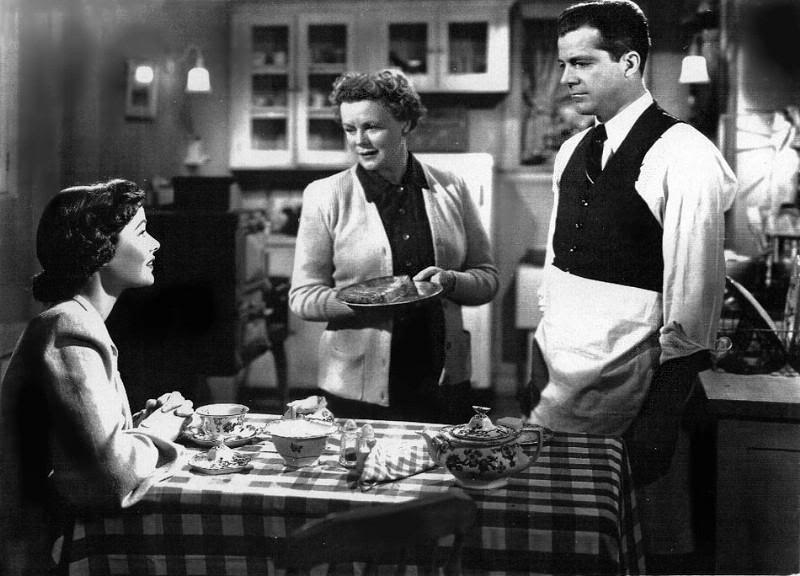
In 1948, the Gouzenko case was ripped from the newspaper headlines of only yesterday: the style of the film was the currently effective style of such films as Henry Hathaway’s The House on 92nd Street, Elia Kazan’s Boomerang, and Jules Dassin’s The Naked City. The director of The Iron Curtain, William Wellman, had a personal style well adapted to the documentary. One of the old warhorses of the studio system, he had been making pictures for 25 years, and his best ones were closely observed slices of reality, often shot on location: Wings, The Public Enemy, The Ox Box Incident, The Story of G.I. Joe. He was a tough-minded individualist, in the Hemingway mould, to whom communism was anathema, so that this rather crudely propagandistic film may have been a labour of conscience. The documentary style in the service of propaganda owes much to Anatole Litvak’s film of 1939 Confessions of a Nazi Spy, and the scriptwriter of that early Hollywood reaction to Hitler’s Germany. Arthur Krims, was the scriptwriter for The Iron Curtain.
A star whose own style and aura suited the documentary as well as Wellman was Dana Andrews, who had already appeared in both The Ox Bow Incident and Boomerang, as well as two films definitive, in a very direct realistic way, of the war and its immediate aftermath: A Walk in the Sun and The Best Years of Our Lives. While Andrews looks little enough like a minor Russian code clerk, his strong silent appearance gives the character of Gouzenko both conviction and sympathy. As the two women representing the poles between which he oscillates, his wife and the temptress sent to lure him back to Mother Russia, Gene Tierney, dark and responsible, and June Havoc, fair and Gypsy Rose Lee’s sister, are presented with broad strokes. And Edna Best, representing a norm of Canadian wholesomeness, is a reassuring quotation from Hitchcock’s prewar The Man Who Knew Too Much. There were many anti-red films to come, but this one set the tone for such as I Was a Communist for the F.B.I., The Red Danube, and My Son John. Its greatest deficiency is only that it is a monotone.
The Boy With Green Hair, with its greater ambiguity, is a much more interesting picture, the first film by one of the major artists of the thirty years after 1950, Joseph Losey. From his first to his last, a sympathetic feminist film, Losey’s eye was always on the underdog and the nonconformist. His baleful British masterpieces, despite their perversities, do not lose sight of that dominant concern: The Servant, Accident, The Go-Between. And with that concern is that major Jamesian theme of the vulnerable child or young person caught in a web of corruption. Eight months after The Iron Curtain, Bosley Crowther liked The Boy With Green Hair much better–“A novel and noble endeavor to say something withering against war on behalf of the world’s unremembered children who are the most piteous victims thereof.”
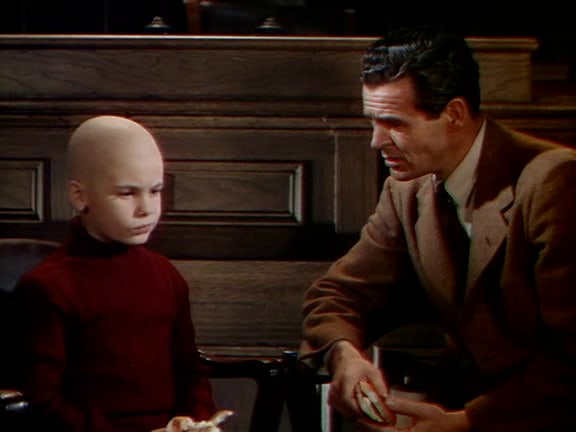
Peter has lost both his parents in the war, and is living with his “gramp”, a kindly old philosopher. The boy takes on the guilt of his generation, the sense that he is alive while those whom he meets in the playtime world of his imagination are dead. With this growing realization, his hair turns green. This allegorical idea is ill-adapted to the revelatory eye of the film as Henry James well knew, when he talked of making “the reader’s vision intense enough” so as to avoid “weak specifications”. What a writer can get away with, a visual artist can not, and contemporary reviewers found the visible greenness of the boy’s hair, and the uncertainty whether it was visible to anyone but himself, a defect in the film. But the two central performances int he film carry enough conviction to sweep such objections away. Dean Stockwell (born 1936) is the boy, already a seasoned child actor out of such films as The Valley of Decision and The Green Years; he would play important child roles in The Secret Garden and Kim before graduating to “difficult” adolescent roles in Compulsion and Sons and Lovers; this year he has moved toward a major comeback, with two major films. And Pat O’Brien by 1948 inspired a great deal of homespun confidence, through a series of priests in the gangster slum (Angels With Dirty Faces) and other solid citizens such as Knute Rockne (with his memorable exhortation to “win one for the Gipper.” These performances are well supported by those of Barbara Hale, always someone to rely on, even before Perry Mason found her, and Robert Ryan, a year after his psychotic villain in Crossfire, showing his versatility in the role of a highly sympathetic child psychologist. This remarkable actor, whom I once saw play Antony to Katherine Hepburn’s Cleopatra, got fewer memorable roles than he deserved in Hollywood, though he left us perhaps half a dozen great performances, of which this is surely one.
The Boy With Green Hari is a very didactic film but one cannot but admire its good intentions, even as one may deplore the malign intentions of The Iron Curtain. But as the Russians closed off Berlin, as America turned in on itself, and voices like Henry Wallace’s appealed for ‘friendship’ with the Soviet Union, these two films were two of the faces of 1948.
Notes by Barrie Hayne
You may also like...
One response to “The Boy With Green Hair (1948) and The Iron Curtain (1948)”
Leave a Reply Cancel reply
-
News

Frances Blau
Toronto Film Society | February 27, 2024On Monday, February 26th, 2024, Toronto Film Society lost longtime friend, supporter, and board member Frances Blau. Known for her sense of humour, her love of film, her generosity,...
-
Special Events

Monday Evening Film Noir Double Bill at the Paradise Theatre
Toronto Film Society | July 8, 2024The Toronto Film Society presents a film-noir double feature at one low price! The Window (1949) in a double bill with Black Angel (1946) at the Paradise Theatre on Monday, August...
Programming

Virtual Saturday Night at the Movies
Toronto Film Society | July 20, 2024Toronto Film Society is back in the theatre! However, we’re still pleased to continue to bring you films straight to your home! Beginning Season 73 until now we have...
4-
 Toronto Film Society | July 8, 2024
Toronto Film Society | July 8, 2024
Monday Evening Film Noir Double Bill at the Paradise Theatre
-
 Toronto Film Society | November 6, 2022
Toronto Film Society | November 6, 2022
-
 Toronto Film Society | August 1, 2023
Toronto Film Society | August 1, 2023
Donate to Toronto Film Society – We’re now a Registered Charity!
-
Copyright © 2017 Toronto Film Society.

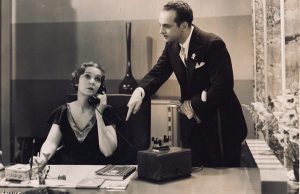
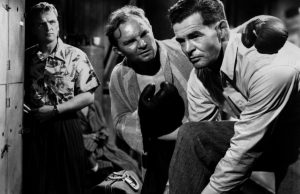
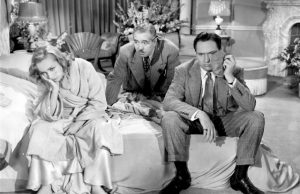
[…] which she made immediately after Gentleman’s Agreement. Back in October I had been adding notes for this film to the Toronto Film Society’s (TFS) website and I discovered that a pretty nice […]